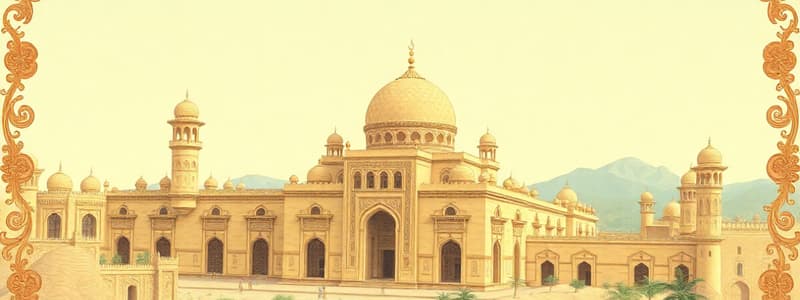Podcast
Questions and Answers
What are the three bodies of water that surround the Arabian Peninsula?
What are the three bodies of water that surround the Arabian Peninsula?
The Arabian Peninsula is surrounded by the Red Sea, the Arabian Gulf, and the Indian Ocean.
Name the two most significant historical economic activities in Oman.
Name the two most significant historical economic activities in Oman.
The two significant economic activities in Oman in the past were fishing and date farming.
Identify two key physical features of the Arabian Peninsula's deserts.
Identify two key physical features of the Arabian Peninsula's deserts.
Vast deserts, such as the Rub' al Khali (Empty Quarter) and the Nafud Desert.
How did the geographical conditions impact the traditional lifestyles in the UAE?
How did the geographical conditions impact the traditional lifestyles in the UAE?
Where does the Nile River flow through before splitting into the White Nile and Blue Nile?
Where does the Nile River flow through before splitting into the White Nile and Blue Nile?
What modern-day country is the ancient city of Carthage located in?
What modern-day country is the ancient city of Carthage located in?
Name a geographical feature that supports farming in the Nile Valley.
Name a geographical feature that supports farming in the Nile Valley.
Name a location where the Atlas Mountains stretch to.
Name a location where the Atlas Mountains stretch to.
What were the resources mainly traded in North Africa?
What were the resources mainly traded in North Africa?
What is the name of the artificial lake, created by the Aswan Dam, which is also one of the largest in the world?
What is the name of the artificial lake, created by the Aswan Dam, which is also one of the largest in the world?
Flashcards
Arabic Language
Arabic Language
Arabic is a widely spoken language in West Asian countries.
Arabian Peninsula Boundaries
Arabian Peninsula Boundaries
The Arabian Peninsula is bordered by the Red Sea, Arabian Gulf, and the Indian Ocean.
Holy Cities of Islam
Holy Cities of Islam
Mecca and Medina are located in the Arabian Peninsula
Vast Arabian Desert
Vast Arabian Desert
Signup and view all the flashcards
Arabian Peninsula Location
Arabian Peninsula Location
Signup and view all the flashcards
Oman's Past Economy
Oman's Past Economy
Signup and view all the flashcards
Arabian Peninsula Features
Arabian Peninsula Features
Signup and view all the flashcards
Oman & UAE Economy Factors
Oman & UAE Economy Factors
Signup and view all the flashcards
Atlas Mountains Location
Atlas Mountains Location
Signup and view all the flashcards
Sahara Desert Extent
Sahara Desert Extent
Signup and view all the flashcards
Study Notes
Geography of West Asia
- Arabic is a common language in all West Asian countries.
- The Arabian Peninsula is surrounded by the Red Sea, the Arabian Gulf, and the Indian Ocean.
- Mecca and Medina are considered two holy cities of Islam, and are located in the Arabian Peninsula.
- Rub' al Khali is a vast desert located in the Arabian Peninsula, also called the "Empty Quarter".
- Falaj is the traditional irrigation system used in Oman.
- The Arabian Peninsula is located in Southwest Asia.
- It is bordered by the Red Sea to the west, the Arabian Gulf to the northeast, and the Indian Ocean to the south.
- The peninsula consists of desert landscapes, mountain ranges, and coastal plains.
- Two significant economic activities in Oman in the past were fishing and date farming.
- The Arabian Peninsula features vast deserts like the Rub' al Khali (Empty Quarter) and the Nafud Desert.
- It also includes mountain ranges, such as the Hijaz Mountains and the Oman Mountains.
- Coastal plains are located along the Red Sea, Arabian Gulf, and the Indian Ocean.
- Oases support agriculture in the peninsula.
- Seasonal rivers and wadis are also present.
- Geography significantly shaped the economy of Oman and the UAE.
- Deserts limited agriculture, leading to reliance on oasis farming.
- Coastal areas supported fishing and pearl diving as major industries.
- Harsh desert conditions resulted in a nomadic lifestyle with camel herding and trade.
- The location of Oman and the UAE on ancient trade routes made them centers for maritime trade.
Geography of North Africa
- The Atlas Mountains stretch from the Southwest up into Algeria to the Northwest near the Mediterranean Sea.
- The ancient city of Carthage was located in modern-day Tunisia.
- The Nile River flows through Sudan, where the White Nile and Blue Nile meet near Khartoum.
- The Sahara Desert stretches from the Atlantic Ocean to the Nile Valley in the east.
- The major dam built in the 1960s at Aswan created Lake Nasser.
- The Nile Valley is one of North Africa's most fertile areas.
- Farming is supported by irrigation from the Nile River, silt deposits, and modern dams like the Aswan High Dam.
- Main crops include wheat, cotton, and sugarcane.
- Timbuktu and Djenné were important cities in North Africa as centers of trade, learning, and Islamic scholarship.
- Timbuktu was known for its gold and salt trade.
- Djenné had great Islamic architecture, including the famous mud-brick mosque.
- Caravan trade routes in North and West Africa were crucial for economic and cultural exchange.
- These routes connected West Africa to North Africa and the Middle East.
- Traded goods included gold, salt, ivory, and textiles.
- Trade led to the spread of Islam and knowledge across Africa.
- Cities such as Timbuktu and Gao became centers of commerce and learning.
- Camels, known as the "ships of the desert," were used for transportation.
Studying That Suits You
Use AI to generate personalized quizzes and flashcards to suit your learning preferences.



